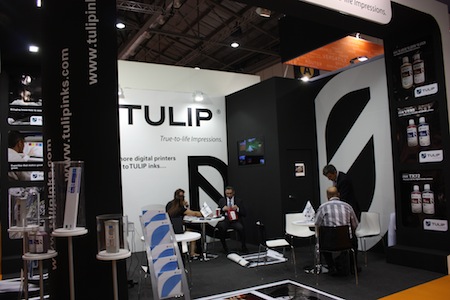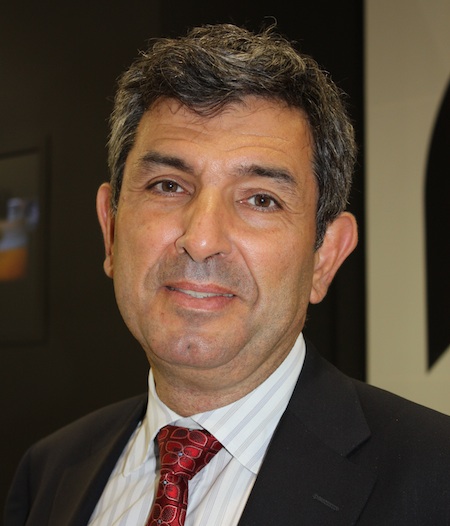 At Fespa show in London, Sabine A. Slaughter spoke with Mr. Ramzi H. Hawa, Managing Director from Tulip Inks, an UAE manufacturer of digital inks.
At Fespa show in London, Sabine A. Slaughter spoke with Mr. Ramzi H. Hawa, Managing Director from Tulip Inks, an UAE manufacturer of digital inks.
There are some colours that are hard to achieve – no matter whether talking about traditional print or digital print: One of these is black, i.e. rich black, and grey and all its gradations; and a glowing rich red and all its hues is also hard to reproduce.
In inkjet printing there are many factors that play a role in the faithful reproduction of colours. It is a careful and highly sophisticated process getting the right mixture of chosen substrate, the inks and print head. Each of the factors influences the other and in order to find the optimum combination extensive testing has to be done.
For ink manufacturers this not only requires a vast knowledge of the ingredients of a certain ink set, it also means that all chemicals and particles an ink contains need to be carefully selected – much like any herb that is added to food might decide about its taste and success: a bit too much of it and the whole effort of cooking a delicious meal ends in disaster.
For digital inks this means that not only the pigment loading of an ink is important but also which and how much of a certain chemical is added to the formulae. In addition, ink manufacturers such as Tulip Inks, often try to take the environment into account – meaning an avoidance of VOC (Volatile Organic Compounds) wherever possible. VOCs are organic chemicals (such as ethyl acetate, glycol ethers or acetone to name just a few) marked by high vapour pressure at room temperature that also have a low boiling point which results in emitting sometimes hazardous molecules onto surrounds when heated or dried with heat. Most printing inks as well as digital inks contain VOCs in one or the other form whereby the drying temperatures of inkjet printers quite often add to emission levels. Here it is the expertise of an ink manufacturer that is required in order to mix in enough VOCs for the inks to perform well however, at the same time ensure to keep the environmental influence as low as possible. The same applies to all other ingredients, be it particles of certain chemicals for colouring or others. In addition, none of the ingredients is allowed to clog up the print heads or tubes as this would result in head failure and high replacement costs.
ICC profiling printers is not only cumbersome but also requires specific knowledge about inks, ink layers, print heads and the behaviour of ink on certain substrates. While there are many solutions out in the market, Tulip Inks as ink manufacturer considers it essential that, when a printer switches to their products, he shall also get the best results he can from their ink. To achieve rich black and all the shades and hues it contains – same as for all other colours – the ink, substrate and print head need to be fine tuned to correspond to the best Δe-values. Tulip Inks is one of the experts when it comes to reproducing true to life images that show the colours as they really are.
It is easy to achieve immaculate print results but only when and if all factors have been taken into account including ambient light. That is why Tulip Inks also profiles certain media. Their customers shall receive the best ink for their use in order to produce superior results. As a one stop solution provider for customers Tulip Inks is also offering ICC profiles and profiling as well as an ink cost calculator that enables printers to calculate the ink costs of jobs beforehand. Customers can download predefined ICC profiles from the website that correspond to their printer, RIP (Raster Image Processor), planned print mode and substrate. The company has experts on hand if a certain ICC profile is not available and helps its customers to define further profiles that correspond to their requirements or define the profiles for them.
 The development of the Tulip Continuous Ink Delivery System (CIDS) originally for the HP water-based printers and afterwards for a variety of others has brought success to the company. CIDS are customized and Tulip Inks develops them for each digital printer type anew. The design criteria for ink systems include that there is no permanent modification to the printer, ease of installation of CIDS and minimizing the possibility of operator errors while robustness of the system is required and durability needs to be maintained.
The development of the Tulip Continuous Ink Delivery System (CIDS) originally for the HP water-based printers and afterwards for a variety of others has brought success to the company. CIDS are customized and Tulip Inks develops them for each digital printer type anew. The design criteria for ink systems include that there is no permanent modification to the printer, ease of installation of CIDS and minimizing the possibility of operator errors while robustness of the system is required and durability needs to be maintained.
Another special service from Tulip Inks is print head cleaning for prolonging the lifetime of a print head. Print heads are designed in such a way that there is a maximum number of accentuations (ink ejection) that a print head can perform before the trigger is getting too weak to perform its tasks and will eventually stop working fully. As ink is directed through the print heads, ideally the whole ink should be ejected through the nozzles in order to form a drop on the paper. However, quite often the ink fluid leaves a little bit of residue behind when travelling through the pipes and the print head. This is not much more just a trace, but over time, it accumulates and just a small trace of residue results in print heads not performing well, nozzles getting clogged or misfiring and the overall performance of the printer is tarnished. As print heads are a quite expensive requirement for an inkjet printer when they need to be replaced, Tulip Inks offers their customers a professional print head cleaning and recovery service. Next to Epson, Xaar, Konica Minolta, Dimatix Spectra and other heads the preventive print head cleaning and recovery services can thus help save costs.
Global Print Monitor: Mr. Hawa, could you tell us a bit more about your company?
Mr. Ramzi H. Hawa: We started our business on inks for digital printers and presses since 1992, the earliest days of digital printing. Initially we have been selling hard solvent and water-based inks. Over time, especially with our development of a delivery system, the Tulip Continuous Ink Delivery System (CIDS), for the HP large format printers, water-based inks became our bestseller. Nowadays, we are producing a variety of inks for large format graphics and textile printing, among them water-based dye and pigment inks, solvent, eco-solvent and mild solvent pigment inks, as well as a strong range of textile inks.
Global Print Monitor: Your ink production...
Mr. Ramzi H. Hawa: Our ink production and manufacturing department is closely monitored and undergoes rigorous and strict controls as we strive to produce inks that show consistent repeatability of jobs. We have stringent demands on our inks that are being used for high quality printing jobs. It is a prerequisite therefore that each and every job needs to look the same as before with faithful reproduction of colours. Choosing the right high value pigments as well as all other chemicals that our inks contain is one of the decisive factors that make our inks outstanding in terms of quality. Before release we are testing our inks extensively in order to satisfy our own strict quality standards as well as industry benchmarks. Induction sealing of bottles and gallons ensures the inks are protected and tamper proof. Batch numbers ensure ink lots can be traced in case any technical issue arises. I can say that our inks are as close as 95 per cent or more to the original manufacturers inks. Our vast experience in ink formulations and solving problems that arise during printing enable us to serve our clients profoundly.
Global Print Monitor: How are your inks designed?
Mr. Ramzi H. Hawa: In order to achieve the results we aim for, we take much care when designing inks. Characteristics such as color gamut, optical density, low odour, scratch / abrasion resistance, light fastness and minimal use of VOCs, print head components and drying time are some of the important factors that need to be taken into account in order to manufacture an ink that is supporting the maximum print head life while at the same time producing superior results. The inks are fine tuned through a process of iteration and repeated testing until the design criteria are balanced and optimized. In addition, we are conscious of the environment and are trying to keep the use of VOCs and hazardous ingredients in any ink formulae at a minimum.
Global Print Monitor: How do you see Fespa in London?
Mr. Ramzi H. Hawa: Fespa is a very good show for us. We are printing live various images with our TULIP VE33 inks showing true to life colours. It seems the stand location, design, and most of all the stunning quality of images we print on the stand have worked well to give a strong impression and attracts visitors.
Global Print Monitor: Thank you very much for the interview.
Founded in 1989 in UAE, Tulip Inks is one of the ink manufacturers that reflects the know-how about how to manufacture inks, how those inks display on various materials in order to achieve a reproduction that is true to life and more important, how to compose inks for different print heads so that the lifetime of a print head is not influenced by the ink used therein. Tulip Inks are sold in the Middle East region, Africa, and other countries and regions worldwide, directly and via distributors and dealers.





